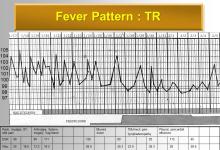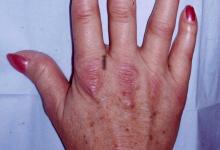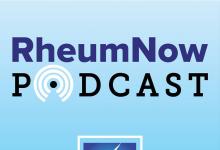Lessons Learned from a Lupus Registry: Two sides of one coin? Save
It's Dr. Janet Pope reporting at RheumNow on our special lupus edition. I'd like to talk about lessons learned from a Canadian lupus registry. Is it two sides of one coin?
What do I mean by that?
I want to talk about a large Canadian registry that sometimes doesn't get as much airtime as maybe it could or should. And our group is called CaNIOS: Canadian Network for Improved Outcomes in SLE. We've enrolled more than a thousand patients. They're seen at least annually and some for many years. So we have a very rich database. These patients are incident or prevalent and they've consented to be in the database.
So what have we learned looking at kid-onset versus adults? We have a unique database in that pediatric rheumatologists and adult rheumatologists are involved in collecting the data. So there's a couple things that I've learned that I think are important in profiling my patients and the risk factors.
If you are childhood-onset lupus, you have more rash, more fevers, more seizures, and yes, more lupus nephritis. If you're adult-onset lupus (in sort of the usual age group we think of lupus compared to kids), you have more arthritis and you still have a high lupus nephritis risk. If you are elderly onset lupus - so the older age group that we wouldn't think of so much but they do exist onsetting then - you have more arthritis, less lupus nephritis and more concomitant Sjogren's. So sickest symptoms as well as Sjogren's overlap.
The other thing we learned looking at our patients is that about a quarter of adult-onset lupus patients have their first lupus symptoms as a child, and that's higher than I thought. A lot of times it's photosensitivity, sometimes it's recurrent oral ulcers not for any other reason. So there's lots of things that can onset as a kid before they get full blown lupus as an adult, maybe a multi-hit hypothesis of inflaming their immune system.
Now we've also looked at costs. So, no surprise that lupus has high costs, both personal, direct as well as societal, indirect and also insurance plans, et cetera. So what do I mean by that?
Number one, those with persistent disease activity when entering our registry have - no surprise - more flares, they need more steroids, they cost more and they develop more damage. We've also looked at work disability, and unfortunately when we excluded the students because we have kid-onset lupus, when we excluded people that are doing unpaid work in the home by choice and people who retired by choice, one in three of our lupus patients still in a contemporary cohort are work disabled. So that's a huge cost to the family, the patient, and also to society.
Similarly, we found that lupus patients who are hospitalized for any reason, they do worse. They likely have more lupus disease activity, more damage and more comorbidities. And that's even if they're just coming in for having a baby or having their gallbladder out, etc. So I think these data highlight that there are high personal and societal costs with lupus and that we can do better. And nicely, we have lots of drugs that have been approved and will be approved probably in the near future that will help our patients.
What's my take home?
If you have onset of lupus symptoms as a child, think of lupus, nephritis, rash, seizures. If you're elder-onset lupus, the older age tertile, think of more arthritis, less GN, and more Sjogren's. And if onset is in those childbearing years of lupus, still be cognizant of lupus nephritis as a high morbid problem that can occur.
Please follow us for our neat lupus month and learn a lot with us. Follow us at RheumNow. Thank you.
More information:
What has been learned (1,2)?
Childhood onset SLE - more rash, fever, seizures, LN
Adult onset SLE – more arthritis, still high LN
Older adults (elderly) – more arthritis, less LN, more Sjogren’s
Approximately up to ¼ of patients who are diagnosed as adults with SLE have onset some symptoms as a child (1).
The CaNIOS registry has also observed the high costs of SLE. For instance, those with persistent disease activity when entering the registry have: more flares, need more steroids, cost more and develop more damage (3). Work disability for those who are not students or unpaid workers in the home, is very high in SLE patients yielding approximately 1 in 3 being work disabled (4). Similarly and not unexpectedly, those with SLE who are hospitalized for any reason do worse likely due to SLE disease activity, damage and also comorbidities (5).
Ask your SLE patients when their first symptom started (to help predict their organ risks). Realize the differences of SLE by age of onset and realize that SLE is costly, especially due to disease activity and damage.
References
1, Kim H, Levy DM, Silverman ED, et al. A comparison between childhood and adult onset systemic lupus erythematosus adjusted for ethnicity from the 1000 Canadian Faces of Lupus Cohort. Rheumatology (Oxford). 2019 Feb 25:kez006.
2. Lalani S, Pope J, de Leon F, et al. Clinical features and prognosis of late-onset systemic lupus erythematosus: results from the 1000 faces of lupus study. J Rheumatol. 2010 Jan;37(1):38-44. doi: 10.3899/jrheum.080957.
3. Peschken CA, Wang Y, Abrahamowicz M, et al. Persistent Disease Activity Remains a Burden for Patients with Systemic Lupus Erythematosus. J Rheumatol. 2019 Feb;46(2):166-175. doi: 10.3899/jrheum.171454. Epub 2018 Sep 15. PMID: 30219771.
4. Baker K, Pope J, Fortin P, et al. Work disability in systemic lupus erythematosus is prevalent and associated with socio-demographic and disease related factors. Lupus. 2009 Dec;18(14):1281-8.
5. Lee J, Peschken CA, Muangchan C, et al. The frequency of and associations with hospitalization secondary to lupus flares from the 1000 Faces of Lupus Canadian cohort. Lupus. 2013 Nov;22(13):1341-8.










If you are a health practitioner, you may Login/Register to comment.
Due to the nature of these comment forums, only health practitioners are allowed to comment at this time.